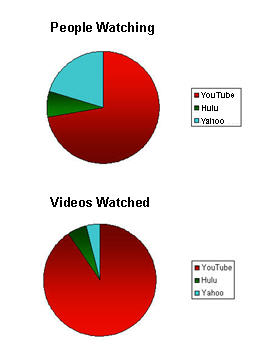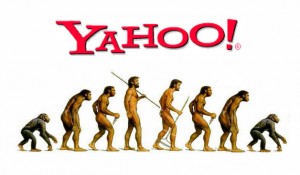Free pair of YouTube socks (unworn) for the best comment on my AdAge article… not here… on the AdAge site. I want to weird-out some marketers by having them hear from the WVFF back row.
Tag Archives: Online Video
Content’s Reign is Over: YouTube Proves Audience & Distribution Trumps All
According to WebProNews, YouTube audiences for the newly revived MGM classic “My Mother the Car” overtook television audiences of Fox’s popular “Lie to Me” and “Fringe” combined in recent weeks.
“Fox’s new shows are topping Neilsen ratings, but that’s no match for YouTube’s power to distribute mass amounts of legacy content to audiences unwilling to leave the YouTube website — or unaware that they can,” said Heather Dougherty of Hitwise.
“Content used to be king, but now distribution is the new sheriff in town,” said Alan Luftanza, who authored a book about YouTube. “The data show that people indeed enjoy moving-picture television shows like “House,” but would rather stick with market leader, YouTube, and watch shows that often lasted well into their 3rd season.”
Luftanza, who worked with Dougherty to conduct the analysis based on March 15 through April 15 viewing habits, observed that Neilsen Ratings reported 12 to 22 people, on average, watched the top 10 television shows. Contrast that to He-Man’s season 1, episode 13 “Life Father, Like Daughter,” which has 2,283 views.”Twelve people is not a lot,” said Luftanza. “I once had more friends than that.”
The ratings show that YouTube’s brand, and loyal audiences, are driving more media consumption than fresh shows by such networks as CBS, NBC, MTV9, and ABC. “It’s so much easier to watch the five episodes of “My Mother the Car” on YouTube instead of digging out the lazer disk or beta tapes from the back of my closet.” said Terry Zipster (Zipster08).”And believe me, I don’t want to be wrestling through my closet since I’m not sure what I might find.”

Michael “Tony Robbins” Buckley (WhatTheBuckShow), left his job as a janitor to host a full-time show on YouTube, and he isn’t surprised. “YouTube is really about two things: the community, and watching retro classics like “Bill and Ted’s Excellent Adventure: Animated Series.” Buckley added, “I have unwavering confidence in YouTube’s ability to maintain it’s leadership in online-video viewing, and I have sexual feelings for women.”
Daisy Whitney, a woman and industry analyst, predicted this phonemon in her December 2008 “New Media Minute” show titled “2009 Predictions.” Whitney said she expected to see Hulu in 2009 assemble the latest television shows, but that YouTube’s sheer mass of loyal viewers would be more important than content to attracting audiences.
“If I had to bet between Desperate Housewives on television and Hulu versus Alf on YouTube, I’d pick the latter any day,” said Whitney, with both palms open to indicate sincerity. “Let’s face it- the audience has chosen YouTube, and Alf’s biting sarcasm is due for a comeback.”
You Spend More Time Watching Online Videos Than Having Sex

If you’re an average online-video watcher, then today you’ll watch about 2 videos, and spend 6 minutes doing so. You’ll most likely be on YouTube, but if you’re watching long-form television on Hulu you’re probably skewing the average by watching for much longer per session/view.
People watching online video in the U.S. now watch more than three hours per month, according to new data from Nielsen Online. Studies suggest people, on average, have sex once a week. My sources on sexual frequency and duration are a bit sketchy here, so you can do your own digging.
So, friends, you’re probably watching online-videos for more time each month than you are having sex — depending, of course, on whether you’re one of those 2.7 minute “slam bam thank you mam” YouTube people, or if you prefer the longer forplay of “Hulu-like” engagements.
And I’m not sure all of that online-video viewing is going to help you in the sex department, but it’s a more reliable, albeit often less climaxic, alternative.
Check out Stephen Shankland’s “Online Viewing Clears Three Hours Per Month.” Neilsen is the source. Do you know how silly that headline will look by the end of the year? First, we’ll have a more difficult time what’s occuring “online” versus “offline” as devices merge. Second, because that three hours will grow dramatically as people begin to consume an episode of Lost (which is, by my crude calculations, roughly the same time it would take to consume about 20 or so short videos on YouTube).
Here are some other notable points from Shanland, and a pretty chart so you can see that YouTube is dominating viewers and videos viewed. But this is going to change when we look at duration spent per site. After all, Hulu has longer-form content, and Yahoo’s 25 million users could, with a little prompting by Yahoo, start watching more video. Hulu has more ad inventory than it has sold, and one can only assume the ad inventory isn’t sufficient for Yahoo to compel its visitors to consume video. Or perpahs Yahoo visitors are busy enjoying display ads and drinking their Tabs or Mr. Pibbs.
- March viewing rose 13 percent to 191 minutes. Total video streams viewed increased 9 percent from 8.9 billion to 9.7 billion. And the number of videos per user grew 7 percent from about 70 to 74.
- If time spent is going up faster than videos streamed, that means a) we’re tolerating 2.7-minute YouTube clips, or b) Longer form content is skewing the average, and we’re continuing to expect our YouTube clips to be 2-3 minutes. I suspect the latter, but Neilsen and the Shankenizer aren’t saying.

The market share:
- Google’s YouTube continues to dominate the category, with 5.5 billion videos and 89 million people using the service in the U.S.
- Hulu is in second place with 348 million videos and 9 million users.
- Yahoo is in third place with 232 million videos, but it’s got more users than Hulu, about 25 million users.
- Revver is not ranking.
Coca Cola and Google/YouTube to Publish Video ROI Study
Coke and Google are soon to publish ROI data on a campaign in Germany that includes online video. The study isolates individuals who were not exposed to television but did see YouTube promotion, and reports incremental consumption data by various digital channels. Paid search leads, of course, and YouTube ranks high (far above banners, which showed almost no impact… and outdoor advertising).
Jens Monsees, who heads consumer goods and healthcare at Google in Spain, teased the audience with info, but results are to be published jointly by Coke and Google. Monsees was speaking at Exlpharma.com’s “Digital Pharma Europe” in Barcelona today.
It’s about time we had a marketing mix study that includes online video, and I look forward to seeing the details. BTW- the average YouTube viewer is 31 years old.
When Will Online-Video Advertising Evolve to “Buddy System”?

This week we saw YouTube pushing its homepage advertising to a new level, selling Lionsgate (“The Haunting in Connecticut”) both the masthead and the standard right “box unit” for a new unit. It’s called the “cross talk” ad, which is a lovely name for it. It really does have a nice effect (from a marketer’s perspective). But what it gets in reach it’s missing in relevancy.
YouTube executives — according to AdAge— declined to say what YouTube charged, but one person with knowledge of the deal said the Lionsgate ad was part of a $500,000 integrated buy that included search and display across Google’s network. YouTube gets 30 million visitors to its home page daily, and delivers 56% (Neilsen) of all videos.
I find it frustrating that a disproportionate amount of the attention toward online-video marketing is on reach instead of relevancy. Let’s take an analogy — if your buddy says you can’t miss new Haunting Film, that unarguably effects you more than finding a “Haunting” flier on your windshield for three consecutive mornings.

Naturally there’s still a vital role for the “fliers” of the medium: banners, Invideo ads, homepage takeovers and other forms of interruption advertising. They’re easy, scalable and get us lots of attention quickly. No video creator can reach 30 million people instantly. But the “buddy system” is also important (and yes I just coined that term, thank you). The online-video stars of YouTube have a “buddy-like” relationship with an audience who are influencing others.
Why are the online-video dollars (growing at 40% this year) still pouring mostly into old forms of promotion wrapped around a new medium? To me, it’s almost like seeing a 60-second television spot that’s a video recording of a print ad.
Uncle Nalts has an answer…The Digital-Marketing Mix is still driven by legacy media-advertising buyers who are cozy with CPM advertising. They know what they should spend, and how much it changes awareness (and maybe intent or purchase). They’re not yet familiar with the unique promotional properties of this online-video medium. The lower the CPM the better the deal. The lower the CPM the better the deal. The lower the CPM the better the deal.
George S., who runs the YouTube Partner program, adds below (see comments): “These decisions are typically made at the agency level, not by YouTube, and they will evolve as social media matures.” He’s right- YouTube can influence how advertisers leverage the medium, but ultimately require agencies to recognize the synergy with media and entertaining videos.
These big programs, initiated by well-meaning media buyers, fail to leverage more cost-effective and higher-impact options. Imagine dozens of known YouTube “stars” (popular characters, personality troupes, comedy troupes, and individual web shows) posting videos about the film in the week prior to its release. It would be fun to see unique creepy spoofs ala the Dr. Slasher video I did (not paid) for MySpace Dr. Slasher. The cost would be nominal relative to the media buy. And we’d see comments, replies, discussions and buzz… Of course we’d need pre-post or test-control research that proves the obvious… a “shout out” by Michael Buckley, para example, is worth more than dozens of ad impressions.
Please not, Uncle Nalts is not saying homepage takeovers are dead because those 30 million YouTube homepage visitors get us vital reach, and Buckley and his fellow creators are reaching only a fraction of YouTube’s daily audience. But the regular YouTube audience (who watch 10 plus videos, and are subscribed to some of the more popular stars) are arguably the ‘trend setters’ that are at the center of a marketer’s bullseye. So if a promotion gets them jazzed, there’s an important and often overlooked spillover.
More importantly, the combination of the homepage — driving people to engaging amateur videos by known personalities — is going to make that “Cross-Talk” work a lot harder.
The Hidden Layer of Online-Video
There’s a continuum of video content online, and it’s often misunderstood because we polarize each end. Let’s stop bifurcating, and look at 3 layers of video content. There are advantages to each one, and we’re missing opportunity in “the great debate” between “professional” (networks) and “user-generated content” (UGC).

Layer 1: Professional content (the only “safe” place to advertise): Advertisers, when they’re not convincing marketers to create their own content, are often urging them to buy ads around “safe” professional content. We don’t see as many ads swarming around such user-generated content (UGC) as cats pooping on skateboards, or dogs riding toilets. Of course the influx of ad dollars into the online-video medium (which is trending upwards while most other ad mediums trend downward) will create a problem. Either ads will get expensive, or online-video’s professional content will have to expand rapidly. True, we’ve seen a proliferation of quasi-pro content that is almost as good as television, and far better produced than most online-video. Unfortunately, that market is hurting more than any because it has neither low production costs or large audiences.
Layer 3: User-generated content (the cheap buy): UGC offers much lower CPMs, so you can reach a wider audience efficiently. You can target specific niches or demographics, and the UGC viewer is, frankly, easier to distract from their content. Want to get someone to respond to your stupid “shoot the monkey” banner ad? You’ll have better luck on a weather and gaming sites than on a professional site (the Wall Street Journal, where audiences are generally engaged in the editorial content). YouTube has limited its number of “partners” who receive a portion of online ads, however. There’s a lot of crap among UGC and a lot of it is inappropriate for ads or copyright infringements. At some point, it’s not worth YouTube’s time to filter creators with tiny audiences. That’s not to say my videos are better than the guy that just started posting on YouTube, of course. Given a random a

Layer 2: The Hidden Online-Video Layer: The hidden layer is the overlooked one between pro and UGC, so I’ve decided to call it “The Hidden Video Layer.” I’m creative like that. And I’ll have to say this 100 times before anyone listens. It’s real, it’s big, it’s important to advertising, and most marketers don’t know it exists. Let’s look at three examples.
- If a YouTube partner (amateur) has a huge following (50 million views and 100K subscribers) on videos about videogames, we’d agree that it’s an incredibly smart place for ads and sponsorships selling the Wii or acne cream. There’s lots of ad inventory in that “hidden layer.” Fred — the most popular kid on YouTube — draws more daily views than many prime-time television shows. More importantly, when you aggregate the views of the top 100 amateur creators, you’ll far exceed the audience of almost any daily television show! Little old Uncle Nalts may have 60 million cumulative views, but gets 100K plus views a day. But combine me with a few more, and you’ve got traffic that beats many websites (and the audience is more engaged).
- If Yahoo saw fit to create a 24×7 “Lindsay Lohan Online-Video Show,” that’s where you’d want to sell your latest Lindsay Lohan action figure (handcuff accessories sold separately). The video content certainly wouldn’t need to be “professionally produced,” and arguably you’d want to keep costs down to $200 per minute. This channel, while not worthy of professional production, is certainly not UGC. BTW- I’m not advocating for a Lohan network any more than I understand Nancy Grace covering the Tot Mom the past 6 months. Jessica fell into a well, hon, and we’re over it.
- To use a non-video example, your aunt’s blog about her daily struggle with foot fungus is somewhat different from the popular TechCrunch blog. But we call them both blogs, and media loooooves its recent stories about bloggers failing to make a living on the medium. Four years ago, we saw stories about brave editors ditching media corporations and starting their own profitable life as a blogger. It’s simple: a blog’s not a blog. And a video channel isn’t a video channel. If you’re advertising, you want to reach large but targeted audiences. That usually means you’re surrounding or interrupting professional content, but not for online video at this point in time. Making well-produced content doesn’t guarantee viewers any more than creating amateur content guarantees a lack of an audience. Make sense? I sometimes spend hours on these posts and minutes on my videos, and dozens will read these words while hundreds of thousands will see my videos. Bad example since neither are professional.

Now this “missing video layer” offers advertisers 8 unique distinctions. I’m holding up four fingers on each of my hands right now, and jumping up and down.
- Established audiences. No smart producer or advertiser would try to build a new Fred show- Fred already has nearly one million people that have “subscribed” and are waiting for his next video. If I pitched “Fred” to NBC two years ago, I’d have been tossed from the building. But Fred usually gets far more views per video than almost any professional content online. Would you rather “roll the dice” by shooting a viral video, developing branded entertainment, or simply leverage Fred to reach “asses in seats”? Many amateur video creators on YouTube, for instance, have audiences that surpass those of entire video sites.
- Loyal and Passionate Audiences: viewers consume their YouTube stars like zombies in pursuit of a brain. It’s an indisputable fact. If Fred starting wearing Madonna rings on his wrist, they’d be back in style.
- Quality: It’s not “professional and TV-like,” but it’s good enough for the audience. I’d rather watch someone I like on a webcam than a boring sitcom or reality-show in HD. If you trust audiences will eventually migrate to “quality” content, then please reexamine what quality means in this medium (at least in 2009).
- Relevance: Ad targeting is easier as we move deeper into amateur content. “The Onion” has brilliant comedy, but “You Suck at Photoshop” probably has a more specified demographic that helps brands target. You want to reach people that celebrate their adolescence (at any age) or soccer moms? Check out Nalts. But Uncle Nalts isn’t likely to deliver too many right-wing, wealthy, retired men to sell time share or cigars. Relevance is easier now that video content and audiences are growing and fragmenting. Growfragmenting. Want to sell toe fungus medicine? Go to a toe fungus blog, not a health ‘n wellness website. There’s a reason Google text ads outperform almost any targeted display media buy. Relevance. Unfortunately, this makes an ad buyer’s job quite complex and will require more creative treatments than television. But video makers take note: this means we’ll need more than three versions of our 60-second spot (default, gay, and the Hispanic/African American). And if creative budgets aren’t getting bigger, than amateur video creators are well poised.
- Ad-Safe Content: Unlike regular UGC, most of “the hidden video layer” content is vetted to be ad friendly (a YouTube partner, for example, gets dumped if they break “terms of service” rules like being fowl or violating copyright laws). That’s as true for Nalts as it is for The Universal Music Group’s popular channel on YouTube.
- Economic Sustainability: Most of “amateur stars” have low costs. So many are making a comfortable living while expensive video sites struggle (Funny or Die). As an advertiser, I’d rather do a deal with content or a distribution channel that is profitable.
- Cost-Efficient Spends: You can saturate Fred’s channel with ads, or work with him and YouTube on a program that does far more than ads alone. Premium video creators, by contrast, simply need to charge higher CPMs given their higher cost-structure-per-view.
- Scale: The deeper advertisers go into “the long tail” of video content the better their chances of being able to broaden and scale campaigns without sacrificing targeting & relevance. We may temporarily saturate some niches, but if there’s audience and advertiser demand, new creators will appear.
We’ve allowed ourselves — as viewers, advertisers, and creators — to obsess on the polars of the content continuum: From Oprah to “David After the Dentist.” From “Lost” to and “the giggling infant.” From “The Office” to “monkey smelling its finger.” There’s a lot in between.
There’s goals in them niche hills, advertisers. Gooolllllddd (he cackles with toothless grin and ominous, shaking index finger). Then again, during a gold rush I like selling shovels.
Will Yahoo Video’s Latest Evolution Work?

There’s news that Yahoo is reversing its web strategy, which was a reversal of a previous strategy. By reversing the reversal, the new reversal may reverse things (see NYTimes).
You see, Yahoo was an early trail-blazer in web video (its DNA was always more media than search), and has gone through a few evolutions.
1) Years ago, the technology company dreamed up plans for elaborate talk shows, sitcoms and other TV-type shows. But the expensive attempts to transport TV entertainment to the Internet “were all disasters,” said Trip Chowdhry, a senior analyst for Global Equities Research.
2) Then it scrapped this model, and has acted as a distributor for audio, video and photographs from other media companies. There were some lower-profile exceptions, like “The 9,” which was reborn as “PopTub” on YouTube).
3) Now the Yahoo producers are identifying their biggest audiences and building short Web shows for those groups of people. Instead of producing TV, Yahoo now recaps TV in a daily show called “Primetime in No Time.” Yahoo says the two- to five-minute-long show has an average of 400,000 daily streams, making it one of the most popular recurring series made for the Web. Can web video about TV survive, and can it be done by a third party? We’ll see
So I jest about this third era being a reversal of a reversal, because Yahoo is smart to produce shows based on the interests of large audiences (as evidenced by their consumption of non-video content about a particular subject). If people like stamp collecting, they’re going to eventually want videos featuring their favorite stamps or, um, celebrity collectors. And we marketers were kinda trained to find an audience need/interest before creating a product. We marketers would rather sponsor someone that already has an audience, rather than someone with great “promise” that may some day attract an audience.
That’s so basic even a marketer can figure it out.
The 7 Things Every Marketer Should Know About Online Video
Here is the fresh new list of 7 things every marketer should know about online video. This will be on the final exam, and it’s not “open book.” Remember folks, I’m not the greatest marketing director in history. And I’m certainly not the best online-video creator (even though I’m the second Google result when you search “fart”). But I don’t know many other people that have a leg firmly placed in each world… marketing and online video.
This list can save you months of research, reduce your risks, impress your colleagues and help you lost 20 pounds in 2 weeks.

- They’re Here. Your customers are watching exponentially more videos online than they were 6-12 months ago. Don’t pull a Bud.tv, but recognize that “watching and experimenting” can be as dangerous as making calculated investments in the space and measuring them.
- Buyer’s Market. The ROI of reaching customers via online-video is better today than ever before because it’s a buyer’s market. Assess your options, run tests, measure and scale. But if you spend the next six months on the first step, you’ll lose revenue potential and find the space shifted while you were stuck in “ready, aim” mode.
- Find a Sherpa. A calculated investment means you’ve done 3 things- you’ve been prudent about your spending, followed the rules of social media, and analytical on results. The best way to be prudent and stay within social media is to find a “sherpa” who has learned the mountain. Someone who already knows the taste of success, and the pain of making a mistake.
- Analyze Impact: Every stupid list has a “measure and improve” step, but let’s get specific. Very few brands will measure online-video’s direct impact on sales. Likewise, I can’t tell you that paid search is selling my product, but I’ve doubled its budget every year because have good assumption-based ROI models. If you can’t track sales, simply do a test/control or pre/post using the next realistic proxy measure/driver of sales (enrollment, site visit, intent, awareness).
- Measure Persuasiveness Not Impressions. If you read the third tip, then we agree that impressions is the worst proxy ever. A video view is different from the fraction of a percent of banner impressions that actually get registered by the human eye. We know that, and we accept that if we engage a prospect in an entertaining and persuasive manner for 30-90 seconds, than we’ve increased intent to purchase. Just like a good salesperson is more effective than a brochure, video is the most visceral, engaging and persuasive form of mainstream media… especially if the audience connects with the star. If impressions are exciting to your boss, then stick with nickel CPMs via ad networks. There’s a reason they’re a nickel.
- Please Don’t Just Advertise. You’re going to use this channel to advertise- brands will always advertise. But think beyond the ad play– it’s public relations, sponsorship and product placement too. An online-video star is like a small network or publication. He or she has a loyal audience, and you want to be more than an ad. You want to be a giveaway on Oprah or a Coke cup on the American Idol judges table.
- Find Existing Crowds, Don’t Try Gathering Them. Please don’t invest in your own content or building a brand-focused entertainment channel (bud.tv). Nobody cares about your brand but you. Find people that have spent the past two years growing audiences who have “asses in seats.” Don’t put on a broadway show about your product- participate in the show that’s already “standing room only.”
Hulu.com: Full of Hot Air; AppleTV Must Save Us.
I got all excited when I read that Hulu.com will distribute DailyMotion.com videos. Sadly, like most of the most-subscribed YouTubers, less than 5% of my traffic occurs beyond YouTube. I couldn’t even remember if I post to DailyMotion. That’s because YouTube dominates, but also because people on other video sites aren’t as loyal to them, and watch a fraction (maybe 5-10 percent) of the videos per week that a hardcore YouTuber devours.
Back to Hulu. A search for “Nalts” on Hulu oddly produces just one result. One. A bit lower than the 739,000 items that Google finds. And it’s… a link to my fart video on “Funny or Die.” Not “Farting in Public.” No, the original short film, in which I fart at my son. That’s hot air, friends.
It doesn’t appear that Hulu is yet picking up the DaiyMotion videos yet. And who knows if they’ll go beyond “official content.” You see, a Nalts search on DailyMotion reveals HBO’s HookingUp as “Official Content,” but the Nalts videos lacks that badge o’ honor. I don’t expect Hulu.com to attract many fans of amateur short-form content in the near term. And we can be sure that long-form, network produced content will rise far above the charming little YouTube weblebrities.
In a hurry? Let’s get to the point, shall we? May I just pop the friggin’ industry’s “Hulu proved TV online works” zit for a moment? Can I just squeeze my fat fingers around this lemming-like nonsense and shoot some pimple juice in your eye?
- First let me acknowledge that Hulu is far better than I ever expected. It’s simple, and it’s proof that networks can play well together… when facing a common enemy. The hulu party is over, however, once we all have media devices that don’t care where the video lives (hulu or nbc.com), because then the networks will then again fight to get viewers on their own sites again… where they have control of metrics and ads.
- I don’t yet watch a lot of Hulu, because I prefer to have my long-form media intravaniously dripped while I’m in a reclining position in bed. And I like the HD quality of AppleTV/iTunes, or the cost/convenience of my NetFlix/Roku device (all-you-can-eat movies for $9 a month plus a $100 device). I tolerate my horrible Verizon DVR (with its perverse $19.99 monthly cost), but that SOB going OUT tomorrow afternoon. It will be replaced by a TiVo plus a $5 Cablecard rental. Oh, sweet TiVo. I’ve longed for your angelic plink sound for two years. I did manage to get Boxee to stream Hulu on my AppleTV (thanks Peter Coffin), but I lost all of that when Apple pushed out an upgrade over the weekend. I’m too lazy to reinstall it, and it was a clumsy interface and poor quality. But I still dig Boxee, and it’s new.
- But back to Hulu and its hot farty air. I swear I’m going to punch the next journalist that rants about Hulu’s profit relative to YouTube. For starters, have you ever purchased media? Any print/TV media seller will gladly toss in an assload of Internet ads as a “value add.” So the networks, in a fit to jolt Hulu’s economic story, simply stopped giving away free Internet inventory. Given a relatively lean cost structure (outsourced to India), the Hulu site was *poof* “profitable.” And let’s put profit into context- I’d estimate that 5-10 minutes of Superbowl ads made more than Hulu.com’s topline last year.
- There’s no mistaking that Hulu is perceived as “safe” to advertisers. Just quality content. No crazy consumer-generated videos that corrupts advertising as we know it. Who wants their Cash for Gold ad next to David After the Dentist? Hulu solves that passive-aggressive motive of the mass media buyer (who regrets giving up his art passion for a soulless existence buying inventory). The media buyer can reluctantly “get digital” without having to actually talk to his agency’s red-headed stepchild — the girl we like to call the digital media buyer (he doesn’t mind suffering her mindless droning at happy hour, but her good looks are offset by the fact that without them she’d be working at the Department of Motor Vehicles).
- Meanwhile we have to assume two things. First, Google will find a way to monetize its 90 plus percent share of online-video consumption beyond the “tip of the iceberg” it monetizes today. And sooner or later, Google will give larger networks a vehicle to monetize content that’s at least as good as Hulu.
- So the market is maturing, and I underestimated Hulu.com. But ultimately the game changer is not a website with all of the networks shows partying together with ads. That’s progress, but that’s just the first step of a much more interesting movement.
- We’re getting so very close to having one dang media center in our home that has access to our own digital video, and web’s. I want comfortable access from any TV in the house, without 12 devices and contracts. I’ve got my money on Apple changing the game (like they did with music and mobile/pda/phone) in 2009/2010 with a new version of AppleTV (someone right that down). The Supercharged AppleTV is going to play better with YouTube.com and Hulu.com, and it’s going to provide the option to download and watch in HD (as it does now) or watch in lower resolution with ads for free. Maybe there’s a monthly fee, but not 8 different ones.
And that, friends, is lovely. And the only loser in my futuristic super-media device that will be the Comcasts and Verizons, who know as much as elegant interface as I know about how to write a short blog post. I’ll be glad when we dissintehrmediate these fools (even if they supertax our bandwidth), and so will Hulu and the networks. Hey Verizon- love the big pipe you installed in my home, but I can’t wait to fall asleep to the sweet sound of TiVo and know I’ll never have to use your stupid interface again.
Well now it’s 10:30. I think wifeofnalts will be asleep, so I can probably sneak in a few episodes of Season 3 Lost now. I borrowed this season after buying the first two on AppleTV. And now I have no patience for changing DVDs and suffering through their irritating introduction and transitions. Meh.
You laugh, but some jackass analyst is going to find a way to organize and profit from these Nalts-futuristic insights, and I’m posting this nonsense for free.
Dismal Advertising Forecast- But Online-Video Has Immunity Idol
Despite this gloomy IDC report (AdAge) about online-advertising contracting, online video will flourish. And I’m not the only guy who thinks so.
IDC’s director for digital media and entertainment, Karsten Weide, tells AdAge that online advertising spending will be soft the first half of 2009 (but online advertising will do better than the economy at large). Weide says video is currently “enjoying the high ground,” especially as use increases.
“People are accessing video services not just on their PCs, but increasingly in the living room,” he said. “That is really where it’s at.”
Now the IDC tends to focus on ad spend that it can measure, and that includes things like display ads besides video, overlay ads (pop-up over bottom 20%), and those satanic pre-rolls. What it doesn’t always include is the big content deals between brands and media properties that don’t run through agencies or media buyers. Daisy Whitney has pointed this out before.
There’s also another aspect of online-video that is often missed: Revenue for content creators & online-video “stars” that aren’t really advertising… sponsorships, custom content, product placement, and the like. If you include video production that is deployed online (and you shouldn’t), the online-video share of ad dollars is far higher.
I like a booms or a busts because they favor innovation. A boom means lots of experimental spending. A bust means dollars move to stupid vehicles to higher impact and targeted vehicles, and online video only needs one thing this year...
Online-video needs to demonstrate business value beyond awareness (reach/frequency) and direct response (and it’s a crappy vehicle for the latter). That means I hope to see Dynamic Logic and Insight Express surveys (surveys comparing test versus control) that show the impact of online-video on attitude, intent and purchase behavior. And I want them nowwwww!!!! People?
Here’s why online-video gets a crappy rap. It’s often compared to the CPM of display ads. That’s like comparing a grocery flier to good advice from a friend. Online-video is getting exponentially more attention (as defined by awareness of the actual content), and often the context gives it an additional credibility boost. If my favorite online-video star endorses a product, it’s more meaningful — I trust you’ll agree — than an ad alone.
So let’s get those studies going, people. You want free content “on demand” from your couch? You gotta show marketers this works.

